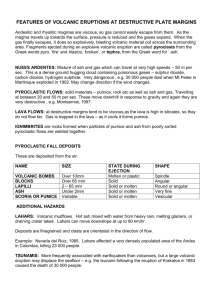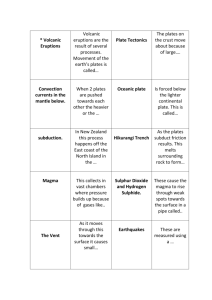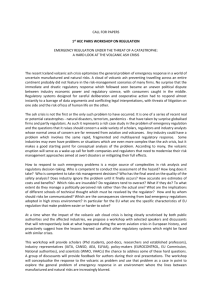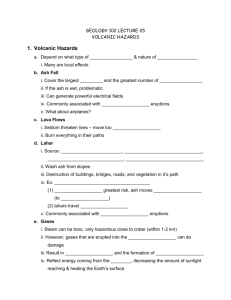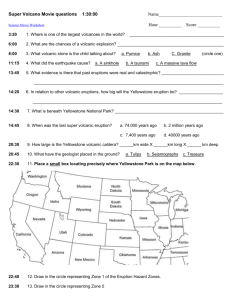Word - WMO
advertisement
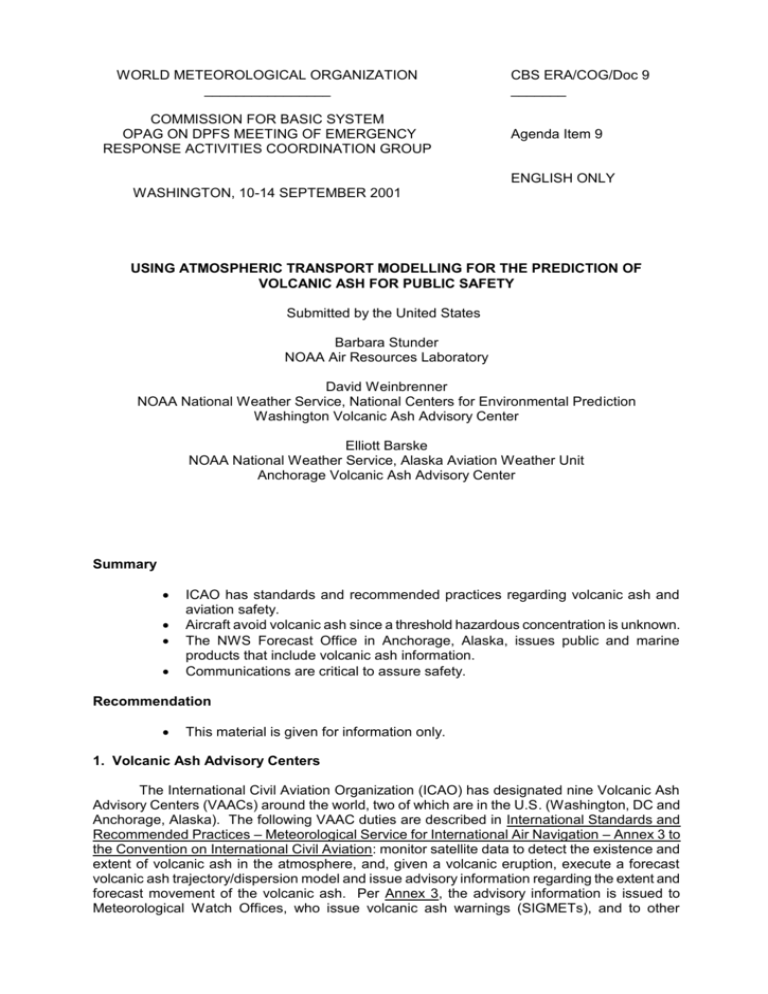
WORLD METEOROLOGICAL ORGANIZATION ________________ COMMISSION FOR BASIC SYSTEM OPAG ON DPFS MEETING OF EMERGENCY RESPONSE ACTIVITIES COORDINATION GROUP CBS ERA/COG/Doc 9 _______ Agenda Item 9 ENGLISH ONLY WASHINGTON, 10-14 SEPTEMBER 2001 USING ATMOSPHERIC TRANSPORT MODELLING FOR THE PREDICTION OF VOLCANIC ASH FOR PUBLIC SAFETY Submitted by the United States Barbara Stunder NOAA Air Resources Laboratory David Weinbrenner NOAA National Weather Service, National Centers for Environmental Prediction Washington Volcanic Ash Advisory Center Elliott Barske NOAA National Weather Service, Alaska Aviation Weather Unit Anchorage Volcanic Ash Advisory Center Summary ICAO has standards and recommended practices regarding volcanic ash and aviation safety. Aircraft avoid volcanic ash since a threshold hazardous concentration is unknown. The NWS Forecast Office in Anchorage, Alaska, issues public and marine products that include volcanic ash information. Communications are critical to assure safety. Recommendation This material is given for information only. 1. Volcanic Ash Advisory Centers The International Civil Aviation Organization (ICAO) has designated nine Volcanic Ash Advisory Centers (VAACs) around the world, two of which are in the U.S. (Washington, DC and Anchorage, Alaska). The following VAAC duties are described in International Standards and Recommended Practices – Meteorological Service for International Air Navigation – Annex 3 to the Convention on International Civil Aviation: monitor satellite data to detect the existence and extent of volcanic ash in the atmosphere, and, given a volcanic eruption, execute a forecast volcanic ash trajectory/dispersion model and issue advisory information regarding the extent and forecast movement of the volcanic ash. Per Annex 3, the advisory information is issued to Meteorological Watch Offices, who issue volcanic ash warnings (SIGMETs), and to other organizations within the aviation community. The U.S. advisories are issued over the Global Telecommunications System (GTS), Family of Services (FOS), World Area Forecast Satellite Broadcast System (WAFS), the Aeronautical Fixed Telecommunications Network (AFTN), and to the public on the Internet. The dispersion model graphical output is issued over WAFS and also the Internet. The dispersion model output is used for guidance only, and typically is the basis of the forecast given in the “Outlook” section of the SIGMET and Volcanic Ash Advisory. 2. Dispersion Forecasting Volcanic ash dispersion models estimate ash concentrations downwind. Since both the amount of ash emitted and a threshold concentration delineating hazardous conditions are unknown, aviation practice has dictated avoiding all volcanic ash. Uncertainties associated with real-time volcanic ash dispersion modeling can result from estimates of the eruption ash column height, ash distribution within the column, eruption duration, and ash particle-size distribution. Also, some volcanoes are in regions of the world with a low density of upper-air weather observations. This results in a lower quality meteorological analysis, which affects the meteorological forecast, and, in turn, the dispersion forecast. 3. Public Forecasts The U.S. National Weather Service Forecast Office in Anchorage can issue special volcanic ash products to the public; marine forecasts can include volcanic ash information. These products are based in part on atmospheric transport model output. The public product typically includes information such as when the leading edge of the ash will reach a given location and indicate whether the ash is reaching the ground (see attachment). 4. Communications Issuing volcanic ash warnings is contingent upon being notified of an eruption. Other than personal observation or detection of an ash plume in satellite or radar imagery, volcano observatories and geological organizations are important sources of information about the occurrence of an eruption. The U.S. Geological Survey (USGS) monitors many active volcanoes in the U.S. and hence should be aware of eruptions and possibly pre-eruption unrest at monitored volcanoes. Both the Anchorage and Washington VAACs maintain close relationships with geological organizations within their areas of responsibility, thereby contributing toward timely product dissemination. Volcanic ash products, such as descriptions of the observed volcanic ash cloud, dispersion model forecasts, and text forecasts and warnings, must be disseminated to the appropriate recipients to assure public safety. In areas with active, or potentially active, volcanoes, relationships between the organization issuing products and emergency management personnel are important, just as is the case for other hazardous weather phenomena. Attachment. Example NWS volcanic ash public product. WEATHER BULLETIN NATIONAL WEATHER SERVICE ANCHORAGE AK 400 PM AST SAT JAN 20 2001 AKZ161-210700BRISTOL BAY INCLUDING KING SALMON - NAKNEK AND DILLINGHAM 400 PM AST SAT JAN 20 2001 ...VOLCANIC ASH WARNING... FOR THIS AFTERNOON AND TONIGHT. ASH FROM THE ST. AUGUSTINE VOLCANO WHICH ERUPTED AT 230 PM THIS SATURDAY AFTERNOON IS MOVING NORTHWEST TOWARD BRISTOL BAY. THE LEADING EDGE OF THE ASH SHOULD REACH THE KING SALMON AREA AT 500 PM. THERE ARE INDICATIONS THE FALLOUT FROM THE ASH CLOUD IS REACHING THE GROUND. A WARNING MEANS A SERIOUS THREAT TO LIFE AND PROPERTY IS OCCURRING OR IMMINENT. REMAIN AT HOME OR INDOORS. REDUCE OUTSIDE ACTIVITY. KEEP WINDOWS AND DOORS CLOSED. DO NOT EXERCISE OR SMOKE. DO NOT BURN WOOD IN STOVES OR FIREPLACES IF THE WOOD HAS VOLCANIC ASH ON IT. THE NEXT STATEMENT IS SCHEDULED AT 7 PM.

